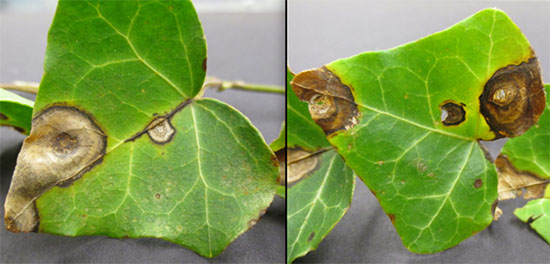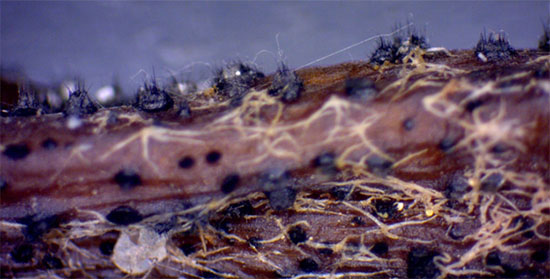Issue 3, May 11, 2015
Anthracnose on Herbaceous Ornamentals
Anthracnose is the name given to group of plant diseases caused by related genera of fungi. Anthracnose diseases can affect both trees and herbaceous ornamental trees. The University of Illinois Plant Clinic has diagnosed both trees and ornamental plants with anthracnose this year.
The tree anthracnose diseases tend to be more familiar, with sycamore, oak, maple, and ash trees commonly affected. On most tree hosts, anthracnose is not a serious concern. General symptoms of anthracnose are large, amorphous, necrotic lesions on leaves. These lesions are not bound by veins and can cause leaf distortion. If a tree is heavily infested, premature leaf drop may occur. Usually the plant leafs out a few weeks later and recovers from the infection.
While not as prevalent on herbaceous ornamentals, anthracnose diseases can be a nuisance. They damage the aesthetics of the plant and, if the disease persists, can stress the plant and make it more prone to environmental or other pest issues. In severe causes they can be lethal.

Anthracnose on English Ivy. Photo credit: Diane Plewa / University of Illinois Plant Clinic.
Symptoms on herbaceous ornamentals are similar to those on trees. The lesions typically first appear as dark spots which coalesce and form large, irregular, necrotic lesions with no defined shape. These lesions may appear on leaves or herbaceous stems. The fungus forms fruiting structures in the lesions. These fruiting bodies are visible as small dark dots in the affected tissue. Many anthracnose diseases also produce small hair-like structures in the fruiting bodies which are visible under low magnification.

Anthracnose fruiting bodies under magnification. Note the black, spikey, hair-like structures associated with each fruiting body. Photo credit: University of Illinois Plant Clinic.
A wide number of hosts can be infected with anthracnose fungi. Commonly seen hosts in Illinois include dianthus, hollyhock, ivy, pansies, snapdragon, statice, and violets (viola).
Anthracnose diseases are favored by periods of wet weather, so we usually see them in spring. By summer the pathogen becomes less active and less infection is observed. Reducing leaf wetness by watering early in the day, watering from below when possible, and properly spacing plants to allow for air movement is recommended for managing anthracnose diseases. The fungus overwinters in infected plant tissue so sanitation is critical. In fall, infected plants should be cut back to the ground. Infected plant material should be pruned out and removed from the area. Fungicides containing the active ingredient chlorothalonil or potassium bicarbonate can be used when the disease first appears. Fungicides containing other active ingredients may be labeled for use on specific host plants against anthracnose. (Diane Plewa)
Author:
Diane Plewa